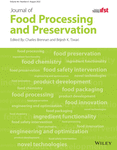Health-promoting bioactive phenolic compounds in different solvent extracts of Curcuma caesia Roxb. rhizome from North-East India
Abstract
The polar protic (methanol, ethanol) and polar aprotic (acetone, ethyl acetate) solvents were utilized to study the polyphenolics, antioxidants, and antimicrobial activities of Curcuma caesia rhizome. Methanol extracted significantly higher TPC (721.83 mg ± 3.82GAE/100 g DW), TFC (271.57 ± 5.41 mg QE/100 g DW), and TTC (242.86 ± 12.20 mg TAE/100 g DW). Chlorogenic acid has the highest concentration (165.00 ± 5.51 mg/100 g DW) among the identified six polyphenolics. The antioxidant activities were maximum in ethanolic extract (for DPPH, ABTS assays) and methanolic extract (FRAP assay). The ethanolic and methanolic extract showed the highest activity against Pseudomonas chlororaphis (11.00 ± 0.06 mm) and Serratia marcescens (11.00 ± 0.12 mm), respectively. The MIC value ranged between 300 and 700 μg/ml for bacteria, 400 and 600 μg/ml for actinobacteria, and 700 and 900 μg/ml for fungi. The TGA and ATR-FTIR analysis revealed the presence of volatile matter, cellulose, hemicellulose, lignin content, and different functional groups in the sample and extracts. The results confirmed higher yield and antioxidant and antimicrobial activities in extracts with polar protic solvents. The identified compounds of the plant extracts possessing several health benefits may be helpful in promoting the species for pharmaceuticals and multiple industrial uses.
Novelty impact statement
Curcuma caesia Roxb. commonly known as black turmeric, is of traditional and medicinal importance. The quantification and characterization of the plant extracts provided the information on health-promoting bioactive compounds, whereas antioxidant and antimicrobial activities support the medicinal and therapeutic uses of the species. The polar protic solvents, viz. methanol and ethanol, could be utilized for the extraction of bioactive compounds from C. caesia rhizome for multiple industrial benefits such as pharmaceuticals, cosmetics, and food sectors.
CONFLICT OF INTEREST
The authors have declared no conflicts of interest for this article.
Open Research
DATA AVAILABILITY STATEMENT
The data that support the findings of this study are available on request from the corresponding author.




